Frank Popper, Roy Ascott e Jeffrey Shaw: visões de um futuro tecnológico e participante nas décadas de 1960 e 1970
DOI:
https://doi.org/10.14393/OUV23-v14n2a2018-4Abstract
ABSTRACTThe article deals with a technological and participatory art developed in the 1960s and 1970s and not yet adequately explored by contemporary art history. This aspect, derived from the tendencies of op art and kinetic art, finds its unfolding in an approach in which technological research and new materials are allied to a process of open work, as described by Umberto Eco, which is directed to an effective participation of the spectator. Although behavioral art has found researchers' interest, the same does not apply to a portion of theorists and artists, perhaps because of its link to the still despised and undervalued op art, considered cold and mechanical. It is therefore the objective of this article to contribute to the rescue of such theoretical and artistic production, based on the theory elaborated by Frank Popper, especially in Art - action and participation, 1975, and as a case study the texts and propositions of the British artist Roy Ascott and the Australian artist Jeffrey Shaw.
KEYWORDS
Op art, kinetic art, Frank Popper, Roy Ascott, Jeffrey Shaw.
Downloads
Downloads
Published
How to Cite
Issue
Section
License
Direitos autorais para trabalhos publicados nesta revista são do autor, com direitos de primeira publicação para a revista. Em virtude de aparecerem nesta revista de acesso público, os trabalhos são de uso gratuito, com atribuições próprias, em aplicações educacionais e não comerciais.











